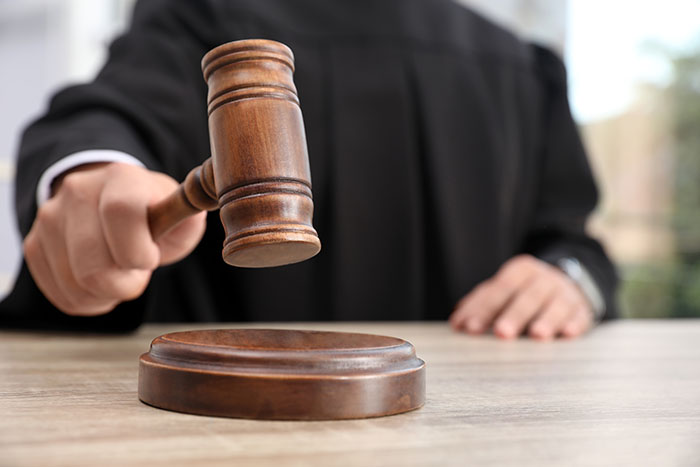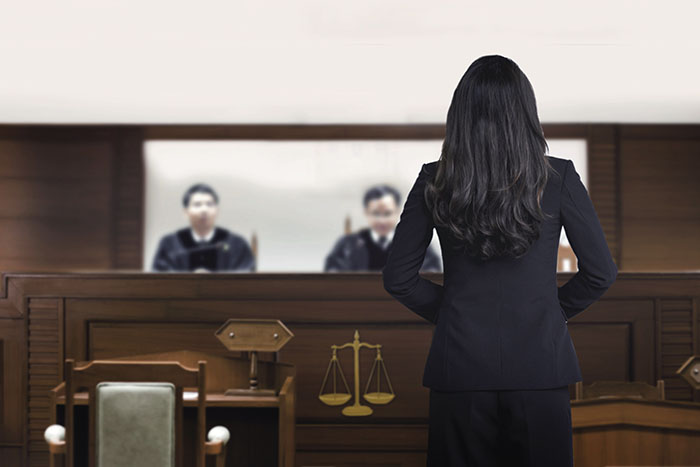During a contentious commercial case, a judge has communicated daily with your opposing counsel on Facebook about pro football – does your client have a right to complain that the judge has committed an ethics violation? Or, a judge on Twitter has “liked” a local newspaper’s slightly biased coverage (pro-prosecution coverage) of the federal government’s prosecution of a corporation accused of polluting federal laws – as the corporation’s defense attorney, do you have a right to complain that the judge has committed an ethics violation? If a judge has violated an ethics rule, should the judge stay on the case, or should a new judge take over? This installment in Holmes PLLC’s Emerging Topics seeks to answer these questions and more.
At least 15 years ago, social media ceased being just a playground for teenagers and media celebrities; accordingly, lawyers appearing before judges as well as their clients must be keenly aware of potential social-media usage by judges overseeing their legal disputes. Indeed, they must actively monitor that social-media usage and take action when appropriate.

Most Judges Need Social Media
Judges, of course, are indispensable to our “adversarial” legal system. They are the independent and unbiased decisionmakers for the “adversarial contests” within our system, which purposely conducts party-initiated and party-controlled “fights with words” so that – from those fights – truth and justice may emerge and thereby resolve legal disputes. Judges provide integrity, impartiality, and discernment to that decision-making process, whether disputes are resolved by fights before juries or before the judges themselves.
Yet judges are people living in social communities and maintaining many diverse friendships and associations. We outside the judiciary cannot expect – nor do we want – our judges to live hermit-like lives, disengaging from and avoiding social relationships. Soon enough, those hermit-like lifestyles would produce poor judges: ones lacking the emotional support coming from social relationships, and ones lacking understanding and empathy for the parties and lawyers in their courts.
In the 1930s, when American state and federal court systems took on their present form, judges participated in social clubs, playing bridge and even having drinks with various members in their communities. Many of those people eventually appeared in legal disputes as parties or lawyers before the judges.
Today, judges participate not only in social clubs and other organizations, but also in social-media domains like Facebook and Twitter. Judges actually need to participate in social media not only for their emotional health (for those who sustain emotional health from social-media interaction), but also for their own careers – many judges must campaign for their jobs or professional advancements by actively presenting themselves and their viewpoints on social media. We outside the judiciary should expect and honor social-media usage by judges.

Managing Social-Media Usage by Judges
Even so, lines must be drawn for regulating judges’ social-media usage. Just as a 1930s judge could not openly discuss a case pending in the judge’s court while playing bridge with a lawyer in the case, likewise a present-day judge cannot communicate or interact with a lawyer on Facebook or Twitter about a case involving that lawyer and his/her client.
How are the lines drawn? Back to our adversarial legal system: we conduct legal “fights” that draw the lines of acceptability for social-media usage by judges. Those fights (whether they occur in trials or in proceedings before regulatory officials) establish “precedents” that educate judges and the broader legal community on the acceptability for social-media usage by judges. This is the “case by case” process for making law via legal fights with words.
In state or federal court, the foregoing fights start with the “Canons” for acceptable judicial conduct. All state courts and the federal courts promulgate substantially similar Canons or other codes for judicial conduct. These Canons guide judges and parties on the acceptability of judicial conduct in a variety of circumstances. In Texas courts, some key Canons applicable to judges’ social-media usage are Canon 2A: “A judge shall comply with the law and should act at all times in a manner that promotes public confidence in the integrity and impartiality of the judiciary,” Canon 2B: “A judge shall not allow any relationship to influence judicial conduct or judgment . . . nor shall a judge convey or permit others to convey the impression that they are in a special position to influence the judge,” and Canon 3B(5): “A judge shall perform judicial duties without bias or prejudice.” If a party believes a judge’s social-media usage has run afoul of one of these Canons, the party should report the matter to both the judge and the regulatory officials, such as the State Commission on Judicial Conduct in Texas or the Commission on Judicial Performance in California.
Recusals and Disciplinary Proceedings
The judge should “recuse from the case” (that is, cease working on the case) in the event either (a) the judge agrees that his/her social-media usage has run afoul of a Canon for judicial conduct or (b) that a decent argument could be made of a Canon violation. Often, judges do not believe they should recuse, thus necessitating a fight over whether they should. Depending on the jurisdiction, some regulatory officials, or an administrative judge, will oversee the fight over recusal – with the party seeking recusal presenting evidence of a Canon violation, and with the judge or party opposing recusal presenting contrary evidence. After the initial decision on recusal, an appeal may result and produce case-law precedent for educating judges and the broader legal community on the acceptability of social-media usage by judges.
Before looking as some of those precedents, remember that the regulatory officials, such as the State Commission on Judicial Conduct in Texas, may conduct investigations and disciplinary proceedings over social-media usage by judges regardless of whether recusal proceedings occur. Those disciplinary proceedings can result in trials and appeals, further establishing helpful precedents to educate judges and others on the acceptability of social-media usage.

Precedents Provide Case-by-Case Guidelines
Surveying some precedents on “acceptability” and “non-acceptability” is revealing. First, virtually all jurisdictions allow judges to accept and maintain friendships on Facebook with lawyers and parties in cases before them. Judges may have such Facebook friendships, but they must carefully manage those friendships to avoid “detract[ing] from the public trust and confidence in the administration of justice.” In re Slaughter, 480 S.W.3d 842 (Tex. Spec. Ct. Rev. 2015) (per curiam).
Returning to an earlier question, a judge’s daily Facebook communications with one party’s lawyer (but not with the other lawyer) over pro football certainly comes close to violating Texas Canons 2A and 2B above – and may constitute grounds for recusal or for disciplinary proceedings. The communications’ frequency poses the problem here. The frequency of this particular Facebook activity does not “promote[] public confidence in the integrity and impartiality of the judiciary” (Canon 2A) and may be “allow[ing] [a] relationship to influence judicial conduct or judgment” (Canon 2B).
Twitter presents decidedly more dangerous terrain for judges than Facebook. Unlike Facebook content, which usually consists of purely casual or leisure subject matter, Twitter frequently constitutes a sounding board for biased expression or political viewpoints. Accordingly, when judges express themselves on Twitter – or interact with others on Twitter – they are stepping into a minefield. Even when judges merely follow Twitter accounts or “like” tweets, they flirt with ethics violations. The precedents bear this out.
In Texas Ethics Commission v. Michael Quinn Sullivan, No. 02-15-00103-CV, 2015 Tex. App. LEXIS 11518, 2015 WL 6759306 (Tex. App. – Fort Worth Nov. 5, 2015, pet. denied), a trial judge lost his opposition to a recusal motion for tenuous Twitter activity. The trial judge had previously dismissed the Texas Ethic Commission’s earlier ruling against conservative political activist Michael Quinn Sullivan. After learning that the judge had merely followed Mr. Sullivan on Twitter (as had thousands of other Twitter followers), the TEC believed the trial judge had bias or prejudice against TEC’s position or at least had shown the appearance of such bias or prejudice. Therefore, the TEC moved to recuse the judge based on at least the appearance of the judge’s bias or prejudice, while also raising (without any evidence) the possibility of ex parte communications on Twitter between the judge and Mr. Sullivan. A visiting judge assigned to decide the recusal motion granted it, and the case was assigned to a different judge.
In United States v. Sierra Pac. Indus., Inc., 862 F.3d 1157 (9th Cir. 2017), a federal judge in California was nearly recused because of his Twitter activity while he was presiding over a case involving a 2007 wildfire that had devastated nearly 65,000 acres in California. The federal government, which blamed lumber producer Sierra Pacific for the wildfire, had earlier reached a settlement. Sierra Pacific sought to vacate that settlement on grounds that fraud caused it to enter the settlement. The trial judge denied Sierra Pacific’s motion. Sierra Pacific complained the judge was biased in the federal government’s favor because he was a Twitter follower of the federal prosecutors on the case, had received tweets about the merits of the case from the prosecutors’ Twitter account, and also had himself tweeted about the case from his then-public Twitter account. The trial judge allegedly tweeted “Sierra Pacific still liable for Moonlight Fire damages,” and linked to a news article about the case – doing all of this while the case was still pending. Sierra Pacific argued that the tweet was not only inaccurate (because no liability finding ever happened), but also appeared to show bias and prejudice against Sierra Pacific. The appellate court (the Ninth Circuit) affirmed the trial court’s ruling upholding the settlement and declined to require the judge’s recusal on procedural grounds. However, the Court recognized the significance of the issues arising from the judge’s Twitter activity, writing “this case is a cautionary tale about the possible pitfalls of judges engaging in social media activity relating to pending cases, and we reiterate the importance of maintaining the appearance of propriety both on and off the bench.” Undaunted, Sierra Pacific filed a petition for writ of certiorari to the U.S. Supreme Court. Sierra Pacific asked the Supreme Court whether the judge’s impartiality might reasonably be questioned “when he not only follow[ed] the prosecution on social media, but also, just hours after denying relief to [Sierra Pacific], tweet[ed] a headline and link[ed] to a news article concerning the proceedings pending before him.” Despite the questions raised, in June 2018, the U.S. Supreme Court denied the petition for writ of certiorari.
Returning to an earlier question, if a judge on Twitter has “liked” a local newspaper’s slightly biased coverage of a prosecution case against a corporation (accused to polluting federal laws), the judge likely has violated ethics rules. The judge has improperly shown “bias or prejudice” against the corporation (Canon 3B(5). This scenario has more similarities with the Michael Quinn Sullivan case than with the Sierra Pacific Industries case.
Holmes PLLC’s Recent Experience
Holmes PLLC recently sought recusal of a trial judge who had demonstrated a pattern, on Twitter, of communicating with and interacting with lawyers opposed to the firm’s clients. This unusual experience trained Holmes PLLC always to monitor judges’ social-media usage while working on cases in their courts – and to advise all business litigants and lawyers to do likewise.
Holmes PLLC was defending a landman and his businesses from high-stakes litigation over an oil and gas deal. Although substantially reversed on appeal, the firm’s clients had suffered a large judgment in the trial court. The trial judge had signed this large judgment against the landman and his companies and then had refused their requests to supersede the judgment pending the appeal. All the while, the trial judge was in an active Twitter relationship with the plaintiffs’ counsel – frequently communicating with one lawyer about personal matters and “liking” her negative views on Twitter about the firm’s landman client. Holmes PLLC not only corrected on appeal the trial judge’s many errors, but also caused the trial judge to recuse voluntarily from further proceedings in the case.
Ideally, judges would refrain entirely from social-media usage, especially when they could interact even tangentially with parties and lawyers appearing before them. Realistically, this total abstinence from social media will never happen. A large portion of judges will engage with diverse communities on social media; indeed, many judges must engage on social media in order to keep their judicial positions or seek advancement. In order to monitor social-media usage by judges and to protect their own rights, parties and their attorneys must have full knowledge of the ethics rules at play (i.e., Canons for judicial conduct), the adversarial contests to test ethics violations (i.e., recusal motions and disciplinary proceedings), and the case-law precedents that define the acceptability of social-media usage by judges.
